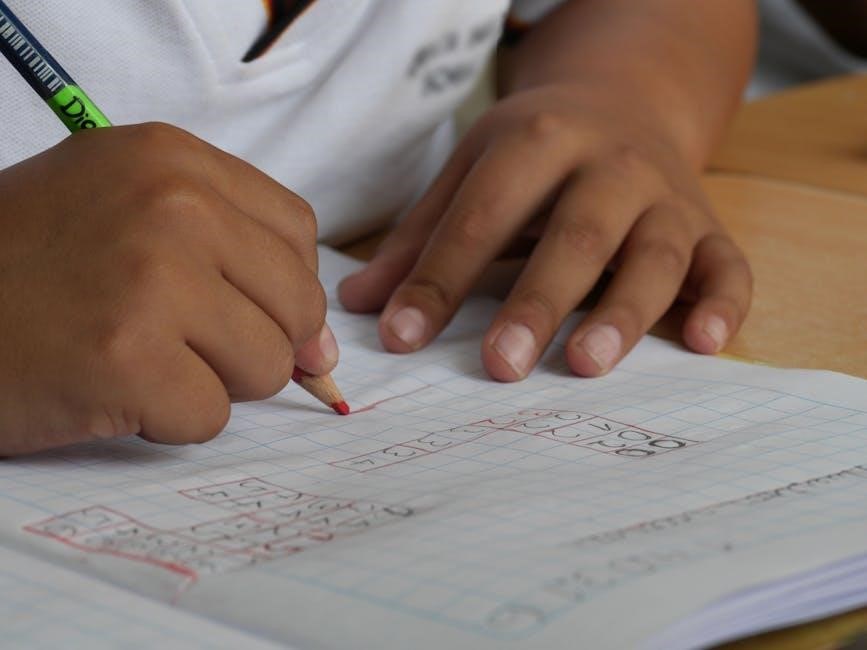The LPN curriculum is designed to provide a comprehensive foundation in practical nursing‚ emphasizing clinical skills‚ theoretical knowledge‚ and critical thinking to prepare students for diverse healthcare roles.
1.1 Overview of the LPN Program
The LPN program is a structured‚ three-semester curriculum designed to equip students with essential nursing skills and knowledge. It combines theoretical instruction with hands-on clinical training‚ ensuring a well-rounded education. The program covers foundational courses such as Nursing Skills I‚ Body Structure and Function‚ and English Composition‚ while also emphasizing critical thinking and patient care. Graduates are prepared to take the NCLEX-PN exam and excel in entry-level nursing positions‚ providing compassionate and evidence-based care in diverse healthcare settings.
1.2 Importance of the LPN Curriculum
The LPN curriculum is crucial for preparing students to meet the demands of modern healthcare. It ensures a strong foundation in clinical skills‚ theoretical knowledge‚ and critical thinking‚ enabling graduates to deliver high-quality patient care. The curriculum’s emphasis on evidence-based practices and patient-centered care equips LPNs to address diverse healthcare needs effectively. By aligning with industry standards and the NCLEX-PN exam requirements‚ the curriculum ensures graduates are well-prepared for licensure and successful nursing careers.
LPN Curriculum Structure
The LPN curriculum structure provides a comprehensive framework blending theoretical education with hands-on clinical training‚ ensuring students meet healthcare standards and are well-prepared for licensing exams.
2.1 Semester-Based Learning
The LPN curriculum is typically organized into semesters‚ with each semester focusing on specific skill sets and knowledge areas. The first semester often includes foundational courses like anatomy‚ English composition‚ and nursing orientation. Subsequent semesters build on this foundation‚ introducing clinical rotations and specialized subjects such as pharmacology and geriatric care. This structured approach ensures students progressively develop the skills and confidence needed for practical nursing. Clinical training aligns with theoretical learning‚ preparing students for real-world healthcare environments and the NCLEX-PN exam.
2.2 Credit Hours and Course Distribution
The LPN curriculum typically consists of 40-50 credit hours‚ distributed across theory‚ clinical‚ and general education courses. Core nursing courses‚ such as Nursing Skills and Body Structure‚ are often 3-4 credits each‚ blending classroom instruction with hands-on training. Clinical rotations‚ which account for a significant portion of credits‚ emphasize practical application in healthcare settings. General education courses‚ like English and biology‚ round out the curriculum‚ ensuring a well-rounded education. This structured distribution ensures students master both the knowledge and skills required for licensure and practice.
2.3 Clinical vs. Theory Components
The LPN curriculum balances clinical and theoretical learning to ensure comprehensive preparation. Clinical rotations‚ such as those in medical-surgical and geriatric nursing‚ provide hands-on experience in real healthcare settings. Theory courses‚ including anatomy‚ physiology‚ and pharmacology‚ build foundational knowledge. Credits are divided evenly‚ with approximately 50% dedicated to clinical training and 50% to classroom instruction. This dual approach ensures students develop both practical skills and the theoretical understanding necessary for effective patient care and professional competence in diverse healthcare environments.

Core Courses in the LPN Curriculum
Core LPN courses include Nursing Skills I‚ Body Structure and Function‚ English Composition‚ and Orientation to Practical Nursing‚ providing foundational knowledge and essential skills for patient care.
3.1 Nursing Skills I
Nursing Skills I is a foundational course that introduces students to essential patient care skills‚ including vital sign measurement‚ infection control‚ and basic medical procedures. This hands-on training emphasizes safety‚ accuracy‚ and patient-centered care. Students learn to use medical equipment‚ perform wound care‚ and assist with daily living activities. The course integrates theoretical knowledge with practical application in simulated clinical settings‚ preparing LPN students for real-world patient interactions. Mastery of these skills is crucial for building confidence and competence in nursing practice.
3.2 Body Structure and Function
The Body Structure and Function course provides a comprehensive understanding of human anatomy‚ physiology‚ and basic biology. Students explore the structure and function of body systems‚ including cells‚ tissues‚ and organs. The course emphasizes normal physiological processes and common deviations due to disease. Topics include the skeletal‚ muscular‚ and nervous systems‚ as well as the digestive‚ respiratory‚ and circulatory systems. This foundational knowledge is essential for LPNs to understand how the body works and respond appropriately to patient needs in clinical settings.
3.3 English Composition
English Composition is a core course in the LPN curriculum‚ focusing on developing strong written and verbal communication skills. Students learn to write clearly‚ effectively‚ and professionally‚ essential for documenting patient care and communicating with healthcare teams. The course covers grammar‚ sentence structure‚ and essay writing‚ emphasizing clarity and precision. It also fosters critical thinking and the ability to articulate ideas logically. Proficiency in English is crucial for LPNs to ensure accurate documentation and effective patient care in clinical settings.
3.4 Orientation to Practical Nursing
Orientation to Practical Nursing introduces students to the fundamental concepts and roles of LPNs in healthcare. This course covers professional standards‚ ethical practices‚ and the nursing process‚ providing a foundational understanding of the field. It emphasizes the importance of effective communication‚ patient-centered care‚ and teamwork. Students also explore the healthcare system‚ legal responsibilities‚ and cultural diversity in nursing practice. This course sets the stage for transitioning into the nursing role and prepares students for the curriculum ahead by aligning expectations with professional responsibilities.
Clinical Training and Experience
Clinical training provides hands-on experience in real-world healthcare settings‚ allowing LPN students to apply theoretical knowledge and develop essential skills in patient care and procedural techniques.
4.1 Medical-Surgical Nursing
Medical-Surgical Nursing focuses on the care of adult patients with various medical conditions and surgical needs. Students learn fundamental disease processes‚ assessment techniques‚ and clinical skills to manage patients effectively. This course emphasizes evidence-based practices‚ medication administration‚ and wound care; Hands-on experience in clinical settings allows students to apply theoretical knowledge‚ preparing them for diverse healthcare environments. The curriculum aligns with NCLEX-PN preparation‚ ensuring students are well-equipped to provide safe and effective care in medical-surgical settings.
4.2 Geriatric Nursing
Geriatric Nursing focuses on the care of elderly patients‚ addressing age-related physiological changes‚ chronic conditions‚ and cognitive impairments. Students learn strategies to promote independence‚ mobility‚ and quality of life for geriatric patients. The curriculum covers pain management‚ skin integrity‚ and end-of-life care. Clinical experiences in long-term care facilities and rehabilitation settings provide hands-on training. This course emphasizes holistic‚ patient-centered care tailored to the unique needs of older adults‚ preparing LPNs to work effectively in geriatric settings.
4.3 Fundamentals of Basic Nursing
Fundamentals of Basic Nursing introduces essential skills for patient care‚ including infection control‚ vital sign assessment‚ and basic life support. Students learn to assist with daily living activities‚ such as bathing and feeding‚ while maintaining patient dignity. The course covers wound care‚ medication administration‚ and mobility techniques. Clinical training in healthcare settings allows students to apply these skills‚ ensuring a strong foundation in providing compassionate‚ effective care. This course is critical for developing core competencies in nursing practice.

Specialized Courses
Specialized courses enhance practical nursing skills in areas like pharmacology‚ pediatric care‚ and maternal health‚ preparing LPNs for diverse patient needs and advanced clinical scenarios effectively.
5.1 Pharmacology for LPNs
Pharmacology for LPNs is a core component of the curriculum‚ focusing on the principles of medication administration‚ dosage calculations‚ and drug interactions. Students learn to safely administer medications‚ understand their therapeutic effects‚ and recognize potential side effects. The course emphasizes critical thinking to ensure accurate dosing and patient safety. Practical applications include calculating medication doses and understanding legal and ethical considerations in drug administration. This training prepares LPNs to handle medications confidently and effectively in clinical settings‚ ensuring optimal patient care and minimizing errors.
5.2 Pediatric Nursing
Pediatric nursing focuses on the care of infants‚ children‚ and adolescents‚ emphasizing growth‚ development‚ and common childhood illnesses. LPNs learn to assess pediatric patients‚ administer medications‚ and provide age-appropriate care. The curriculum covers developmental milestones‚ nutritional needs‚ and communication strategies for pediatric patients and their families; Students gain hands-on experience in clinical settings‚ such as pediatric wards or clinics‚ to master skills in child-specific care. This course prepares LPNs to address the unique needs of children and support their families in various healthcare settings.
5.3 Maternal and Child Health Nursing
Maternal and child health nursing focuses on caring for expectant mothers‚ new mothers‚ and their children. The curriculum covers prenatal care‚ labor‚ delivery‚ postpartum support‚ and child development. LPNs learn to monitor maternal health‚ provide newborn care‚ and educate families on healthy practices. This course emphasizes preventive care‚ nutrition‚ and early detection of potential health issues. Clinical experiences in maternity and pediatric units help students develop skills in assessing and addressing the unique needs of mothers and children‚ ensuring holistic‚ family-centered care.

NCLEX-PN Preparation
The NCLEX-PN preparation integrates test-plan aligned content‚ focusing on safe care‚ health promotion‚ and disease management. Practice exams and clinical simulations enhance readiness for licensure.
6.1 Test Plan Alignment
The LPN curriculum is carefully aligned with the NCLEX-PN test plan‚ ensuring students are prepared for exam content. It focuses on four major areas: safe and effective care‚ health promotion‚ psychosocial integrity‚ and physiological integrity. The curriculum integrates clinical and theoretical knowledge‚ emphasizing critical thinking and practical application. Practice exams and clinical simulations mirror real-world scenarios‚ helping students build confidence and competence. This alignment ensures graduates are well-prepared to pass the NCLEX-PN and excel in their nursing careers.
6.2 Safe and Effective Care Environment
The LPN curriculum emphasizes the importance of creating a safe and effective care environment‚ a key component of the NCLEX-PN test plan. Students learn to manage patient care settings‚ prioritize safety‚ and implement infection control measures. The curriculum covers ethical and legal aspects of nursing‚ ensuring LPNs can provide high-quality‚ patient-centered care. Practical training includes emergency preparedness and safety protocols‚ aligning with industry standards. This focus ensures graduates are equipped to maintain a safe environment‚ promoting positive patient outcomes and professional accountability.
6.3 Health Promotion and Maintenance
The LPN curriculum includes a focus on health promotion and maintenance‚ a critical NCLEX-PN test plan component. Students learn to educate patients on healthy lifestyles‚ disease prevention‚ and chronic disease management; The curriculum emphasizes the LPN’s role in promoting wellness‚ supporting patients in maintaining optimal health‚ and addressing health disparities. Practical training includes teaching patients about nutrition‚ exercise‚ and stress management‚ preparing LPNs to empower individuals and communities toward healthier living. This aligns with the broader goal of improving population health outcomes.

Program Outcomes and Competencies
The LPN curriculum ensures graduates are prepared to provide safe‚ effective care across the lifespan‚ emphasizing critical thinking‚ nursing processes‚ and competencies required for successful practice.
7.1 Student Learning Outcomes
Students completing the LPN program will demonstrate the ability to provide safe‚ effective care across the lifespan‚ applying the nursing process and critical thinking. They will communicate effectively with patients‚ families‚ and healthcare teams‚ and collaborate to promote health and well-being. Graduates will also exhibit cultural competence‚ addressing individual patient needs while maintaining ethical and professional standards. The curriculum ensures students are prepared to meet the demands of practical nursing‚ fostering a strong foundation for lifelong learning and professional growth in the healthcare field.
7.2 Clinical Competency Requirements
Students must demonstrate proficiency in clinical skills‚ including patient assessments‚ medication administration‚ and wound care. They must perform safely and effectively in simulated and real-world settings‚ adhering to professional standards. Clinical competencies include accurate documentation‚ infection control‚ and effective communication with healthcare teams. Students are required to apply critical thinking during patient care‚ prioritizing needs and adapting to diverse scenarios. Successful completion of clinical rotations and evaluations is mandatory for progression and graduation‚ ensuring readiness for entry-level practice as a licensed practical nurse.
7.3 Critical Thinking and Nursing Process
The LPN curriculum emphasizes the development of critical thinking skills and the application of the nursing process. Students learn to assess patient needs‚ diagnose problems‚ plan care‚ implement interventions‚ and evaluate outcomes. Critical thinking enables LPNs to prioritize tasks‚ make sound decisions‚ and adapt to dynamic healthcare environments; The nursing process is integrated throughout the curriculum‚ ensuring students can deliver patient-centered‚ evidence-based care. This foundation prepares graduates to think logically and respond effectively to diverse clinical situations‚ enhancing their ability to provide high-quality patient care.

Admission Requirements
Admission requires background checks‚ immunizations‚ entrance exams‚ and academic prerequisites‚ ensuring candidates are prepared for the rigorous LPN curriculum demands.
8.1 Academic Prerequisites
Academic prerequisites for LPN programs typically include a high school diploma or equivalent‚ with a minimum GPA requirement. Students must also complete prerequisite courses such as biology‚ chemistry‚ and English. Additionally‚ standardized test scores like the TEAS or HESI may be required. These requirements ensure applicants have a solid foundation in sciences and academics‚ preparing them for the rigorous curriculum ahead. Some programs may also require placement tests to assess readiness for coursework.
8.2 Background Checks and Immunizations
Background checks and immunizations are mandatory for LPN program admission. Students must undergo criminal background screening and provide proof of up-to-date vaccinations‚ including hepatitis B‚ MMR‚ and TB testing. Additional health screenings may be required to ensure suitability for clinical training. These requirements are in place to protect patients and comply with healthcare regulations. Failure to meet these standards may result in program ineligibility. Immunization records and background check results must be submitted prior to starting clinical rotations.
8.3 Entrance Exams and Interviews
Entrance exams‚ such as the TEAS or HESI‚ are often required for LPN program admission to assess academic readiness. Interviews with program faculty may also be conducted to evaluate communication skills‚ motivation‚ and suitability for nursing. Applicants must typically submit high school transcripts and complete prerequisite courses before taking these exams. The interview process allows programs to identify candidates with strong interpersonal skills and a passion for healthcare. These steps ensure a competitive and qualified applicant pool for the LPN curriculum.

Career Opportunities for LPNs
LPNs can work in hospitals‚ clinics‚ nursing homes‚ and private practices‚ providing direct patient care. They administer medications and support healthcare teams‚ with growing demand and competitive salaries.
9.1 Work Settings for LPNs
LPNs work in diverse healthcare settings‚ including hospitals‚ long-term care facilities‚ clinics‚ and private practices. They also find opportunities in rehabilitation centers‚ schools‚ and community health organizations. These settings allow LPNs to provide direct patient care‚ administer medications‚ and support healthcare teams. The demand for LPNs is high‚ particularly in geriatric and chronic care facilities‚ making them versatile professionals in the healthcare industry. Their role is essential in various clinical environments‚ ensuring quality patient care and support.
9.2 Job Roles and Responsibilities
LPNs are responsible for administering medications‚ monitoring patient vital signs‚ and assisting with daily living activities. They provide basic care‚ such as wound cleaning and dressing‚ and maintain accurate patient records. LPNs collaborate with healthcare teams to develop and implement care plans‚ ensuring patient needs are met. They also educate patients and families on health maintenance and disease prevention. Their role involves direct patient care‚ observational skills‚ and effective communication‚ making them integral to healthcare delivery in various settings.
9.3 Salary and Growth Prospects
Licensed Practical Nurses (LPNs) earn a competitive salary‚ with a national average of $51‚850 annually. Salaries vary by location‚ employer‚ and experience‚ with higher pay in hospitals and specialized settings. The demand for LPNs is growing‚ with a projected 9% increase in jobs through 2030‚ driven by an aging population and healthcare expansion. This growth ensures promising career stability and opportunities for advancement. The field offers a rewarding balance of competitive pay and fulfilling patient care‚ making it a sought-after profession in healthcare;

Curriculum Guide and Handbook
The LPN curriculum guide and handbook provide detailed course descriptions‚ credit requirements‚ and program policies‚ ensuring students understand the structured path to becoming a licensed practical nurse.
10.1 Course Catalog and Descriptions
The LPN curriculum guide includes a detailed course catalog‚ outlining core subjects like Biological Science I‚ Nursing Skills I‚ and English Composition‚ each with credit hours and prerequisites. Courses such as Body Structure and Function (3 credits) and Orientation to Practical Nursing (3 credits) are foundational. The catalog also lists specialized courses like Pharmacology for LPNs and Pediatric Nursing‚ ensuring a balanced mix of clinical and theoretical learning. This structured approach aligns with NCLEX-PN preparation and program outcomes‚ providing students with a clear academic pathway to becoming licensed practical nurses.
10.2 Program Policies and Procedures
The LPN curriculum handbook outlines policies such as grading scales‚ attendance requirements‚ and clinical conduct. Students must maintain a minimum grade of C in all courses to progress. Attendance and professionalism are strictly enforced‚ with specific guidelines for clinical rotations. Policies also cover program completion requirements‚ including passing the NCLEX-PN exam. Detailed procedures for academic and clinical performance are provided in the program handbook‚ ensuring clarity and accountability for student success and progression through the LPN program.
10.4 Equipment and Technology Requirements
LPN students are required to have specific equipment and technology for clinical and classroom training. This includes stethoscopes‚ scrubs‚ and medical tools. Additionally‚ access to laptops or tablets with internet connectivity is essential for online coursework and simulations. The curriculum guide specifies that students must use approved software for virtual labs and exams. Technology-enhanced classrooms and simulation labs are integral to the program‚ ensuring hands-on learning experiences. These tools prepare students for real-world clinical environments and support their academic success throughout the LPN program.

Credit Transfer and Prior Learning
The LPN curriculum allows for credit transfer and recognition of prior learning‚ enabling students to apply previous academic or work experience toward their degree. Credits can be transferred from accredited institutions‚ and students may earn credits through CLEP exams or competency assessments. Eligible courses‚ such as foundational nursing classes‚ may be waived based on prior learning. This flexible approach helps students accelerate their program completion and reduces redundancy in coursework‚ making the LPN program more accessible and efficient for those with relevant background knowledge or experience.
11.1 CLEP Options for LPNs
The LPN curriculum allows students to earn credits through the College-Level Examination Program (CLEP)‚ enabling them to demonstrate mastery of specific subjects. CLEP exams‚ such as English Composition and Biological Science‚ can reduce the number of required courses. This option is particularly beneficial for students with prior knowledge or experience‚ as it streamlines their path to graduation. By passing CLEP exams‚ LPN students can save time and tuition costs while still meeting program requirements. This flexible approach supports academic progression and career readiness.
11.2 Credit for Prior Learning
Credit for prior learning allows LPN students to receive academic credit for knowledge gained through previous education‚ work experience‚ or training. Eligible courses‚ such as NUR 156‚ NUR 166‚ and NUR 216‚ may be awarded credits based on demonstrated competency. This option streamlines the program for students with relevant backgrounds‚ reducing the need to retake courses. The curriculum is designed to recognize and value prior learning‚ enabling students to progress more efficiently toward graduation and licensure as practical nurses.
11.3 Eligible Courses for Credit Transfer
Eligible courses for credit transfer in the LPN curriculum include general education and core nursing courses completed at accredited institutions. Courses like English Composition‚ Body Structure and Function‚ and Nursing Skills I may qualify for transfer. Credits are awarded based on equivalency and grade requirements. This allows students to transfer academic work completed elsewhere‚ reducing the time needed to complete the program. Transfer credits must align with program requirements and are subject to approval by the nursing program administration.

Program Completion and Certification
Program completion requires fulfilling all academic and clinical requirements‚ graduating‚ and passing the NCLEX-PN exam to obtain LPN certification and licensure.
12.1 Graduation Requirements
Graduation requires completing all curriculum courses with a minimum grade of C‚ fulfilling clinical and theory requirements‚ and maintaining a required GPA. Students must complete the program within three semesters‚ demonstrating competency in both clinical and theoretical aspects. Successful completion makes graduates eligible for the NCLEX-PN exam‚ a critical step toward licensure. The curriculum is structured to ensure readiness for the exam and entry into practical nursing roles.
12.2 NCLEX-PN Exam Eligibility
Eligibility for the NCLEX-PN exam is granted upon successful completion of the LPN program. Graduates must meet all program requirements‚ including clinical and theory components‚ and hold a certificate of completion. The exam assesses the knowledge‚ skills‚ and competencies required for safe and effective nursing practice. The curriculum is aligned with the NCLEX-PN test plan‚ ensuring students are well-prepared. Passing the exam is the final step to obtaining licensure as a practical nurse and entering the healthcare workforce.
12.3 Certification and Licensure Process
The certification and licensure process begins after passing the NCLEX-PN exam. Graduates apply for licensure through their state’s nursing board‚ submitting required documents and fees. The process typically includes a criminal background check and verification of program completion. Upon approval‚ the LPN license is granted‚ authorizing practice in the state. Certification is optional but demonstrates expertise in specialized areas. The curriculum ensures graduates meet all legal and professional standards for practicing as licensed practical nurses.
